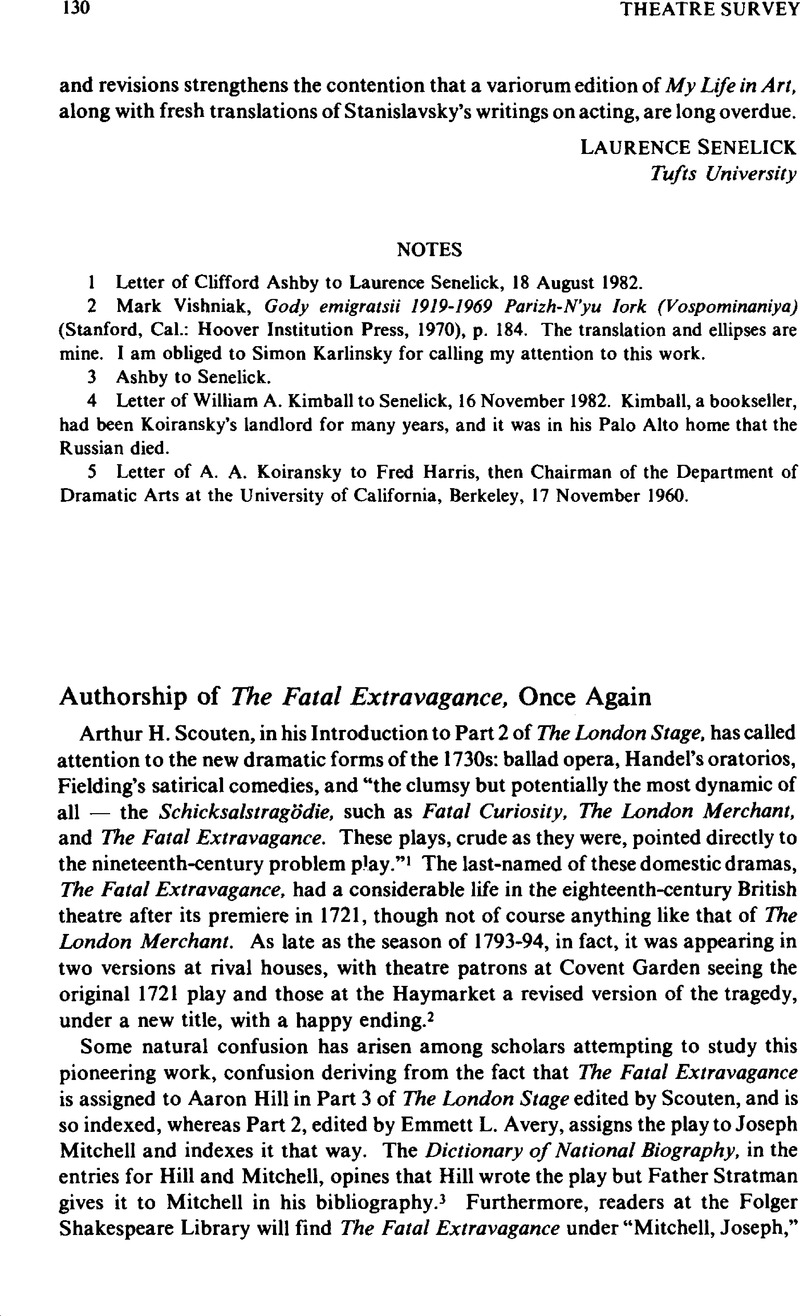No CrossRef data available.
Article contents
Authorship of The Fatal Extravagance, Once Again
Published online by Cambridge University Press: 07 July 2009
Abstract

- Type
- Notes and Documents
- Information
- Copyright
- Copyright © American Society for Theatre Research 1983
References
Notes
1 The London Stage 1660–1800 (Carbondale: Southern Illinois University Press, 1960–1968)Google Scholar, Part 3, p. cxliii. All performance data in this essay unless otherwise noted are from The London Stage.
2 The play was often referred to in the eighteenth century as being of two acts but it was invariably printed without act divisions, there is no evidence of entracte music, and the scenes were always designated “scene” in the various editions over the course of the century.
3 Stratman, Carl J., C.S.V., , Bibliography of English Printed Tragedy 1565–1900 (Carbondale: Southern Illinois University Press, 1966)Google Scholar.
4 Hill, Aaron, The Dramatic Works of Aaron Hill, Esq; (London: T. Lownds, 1760), I, 317Google Scholar. For a discussion of the play, see Brewster, Dorothy, Aaron Hill (New York: Columbia University Press, 1913; rpt. New York: AMS Press, 1966), pp. 97–98Google Scholar; and Winton, C., introd., The Plays of Aaron Hill (New York: Garland, 1981), pp. xv–xviGoogle Scholar.
5 The Fatal Extravagance (London: T. Jauncy, n.d.), sig. ar, a2r. Italics reversedGoogle Scholar.
6 Emmett Avery does not cite supporting evidence for indexing the play to Mitchell or for his statement that “The authorship is uncertain, with both Joseph Mitchell and Aaron Hill connected with the play”: The London Stage (n. 1 above), Part 2, p. 625Google Scholar, under date of 21 April 1721. However, two articles had appeared earlier, both presenting essentially the same line of argument: that inasmuch as Mitchell said that the play was his and Hill did not deny it, Mitchell should be given at least partial credit for it: Dunkin, Paul S., “The authorship of The Fatal Extravagance,” Modern Language Notes, 60 (1945), 328–330CrossRefGoogle Scholar; and Kies, Paul P., “The Authorship of The Fatal Extravagance,” Research Studies of the State College of Washington, 13 (1945), 155–158Google Scholar. Since Kies was a faculty colleague of Avery's at Washington State, it is possible Avery formed his opinion on the basis of Kies's argument.
7 (London: R. Griffiths, 1753), IV, 349.
8 Dramatic Works (n. 4 above), I, i–ii.
9 The History of the Theatres of London and Dublin, From the Year 1730 to the present Time, II (London: T. Davies, 1761), 122–123Google Scholar.
10 History of the Theatres, II, 123.
11 In addition to the first edition noted in n. 5 above, I have seen the so-called Second Edition (London: J. Bicketron, n.d.), which is actually a second issue, differing only in the titlepage. Father Stratman (n. 3 above) cites a Third Edition, Corrected, by Chetwood, which I have not seen. There are two so-called Fourth Editions. Mitchell's five-act version is entitled The Fatal Extravagance: A Tragedy. The titlepage goes on to explain: Presented at the Theatre Royal in Lincoln's Inn-Fields, in One Act; but in this Fourth Edition, improv'd into Five Acts, by the Addition of several New Characters, and Episodical Incidents. This is printed for J. Millan, 1726, and is of course the “sort of Farce” of which I.K. complains.
Obviously in conjunction with the revival at Lincoln's Inn Fields in 1730, an edition of the one-act play was printed: The Fatal Extravagance. A Tragedy. As it is Acted at the Theatre-Royal in Lincolns-Inn Fields. Written by Mr. Joseph Mitchell. The Fourth Edition Corrected. Printed for J. Watts, 1730.
I have not found other editions, issues, or impressions printed during Hill's or Mitchell's lifetime. John Genest refers to Dublin editions of 1721 and 1726, however, without giving further details: Some Account of the English Stage (Bath: H.E. Carrington, 1832), III, 63–64Google Scholar.
12 British Library, Add. MS. 38,728, fo. 117. The Hill family, by the same document, sold the copyright to Hill's letters and to others of his plays, all for £20.


